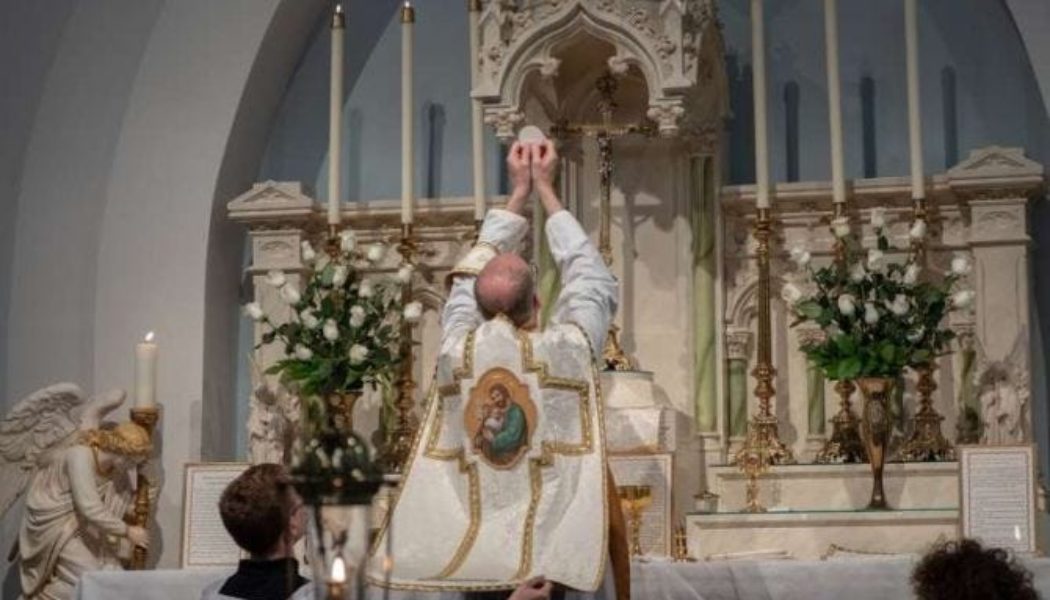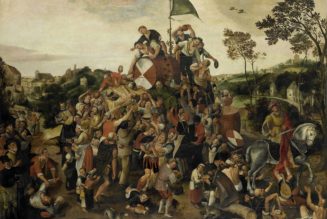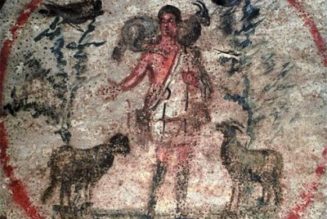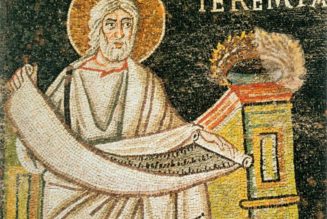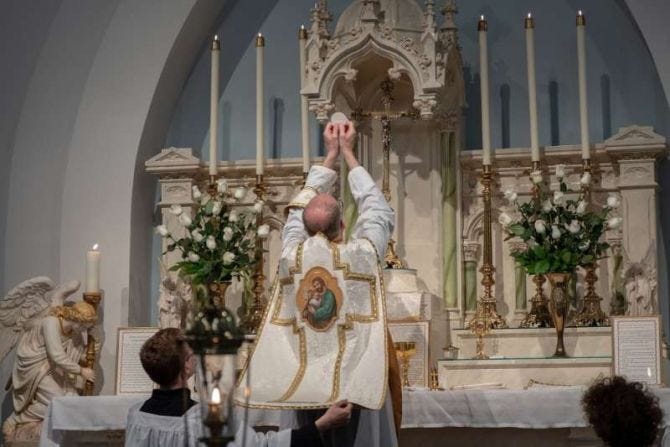
Recently rumors have been flying that Pope Francis is preparing to impose stringent restrictions on the Traditional Latin Mass. Of course, unfounded rumors out of the Vatican are not new, and some journalists have not been able to identify anybody who has actually seen the document in question. Still, even if it ends up being in the class of “Pope Francis is dying” rumors that we have heard for years, such a document would be in character for a pontificate that has emphasized placing hedges around the more conservative, traditional elements of the Church. While his predecessor’s position towards the Latin Mass community can be broadly characterized as one of accommodation, Pope Francis has taken a more confrontational approach.
But why? What is the problem with allowing what is by all measures a small fraction of Catholics to participate in a licit Mass that they find beautiful, reverent, and holy? The very real fact is that Traditional Latin Mass participation has been associated with factions inside the Church who do not accept Vatican II and may even be quasi-schismatic, and multiple popes have taken a variety of approaches in how to deal with groups such as the SSPX.
It is not our place to tell the Holy Father what to do; we are social scientists, not bishops, and one of us is not even Catholic; however the extent to which the TLM community is a schismatic hotbed of negative attitudes towards Vatican II is ultimately an empirical one that is scientifically investigable, and on this point there has been a clear lack of objective, systematically collected data.
The Prefect for the Dicastery for Divine Worship, Cardinal Arthur Roche, has made it clear that he thinks the TLM has a different liturgical theology than the Novus Ordo. There is also the argument that the TLM is an implied, if not explicit, rejection of Vatican II. It seems the Holy Father himself holds this view. Conclusions based on impressions are suspect if they are not supported by more objective evidence.
In announcing Traditiones Custodes (the 2021 round of Latin Mass restrictions), the Pope invoked a survey that he had disseminated among bishops on the question of the Latin Mass. However, in addition to the fact that the survey was of bishops and not Traditional Latin Mass-goers themselves, the wordings used, the exact responses, the representativeness—any one of many things that would be required for a professional survey statistician to objectively gauge the validity of the survey—were completely unknown. Therefore it is difficult to know how seriously to take the results of the survey when only the vaguest details are known.
We, a professor of sociology and theology (and a TLM attender) and a demography/sociology dual-PhD data scientist, have been striving to remedy the lack of transparent, systematically collected, objective data on the TLM community in preparation for a book we are writing: collating all previously published information on the demographics and attitudes of the TLM community (it is not a lot), as well as conducting our own surveys and supplementing our quantitative data with approximately 20 in-depth, semi-structured interviews of TLM Catholics across the country. While our study is on the United States TLM community in particular, given the American Church’s reputation as a hotbed of conservativism, we believe our findings have broad implications.
So what did we find? While we are still processing our data, some relevant themes have already emerged. There is obviously a lot to talk about with TLM Mass-goers, which we will discuss in greater detail in the book, but in broad strokes, this is some of what we learned about Traditional Latin Mass Catholics in the United States:
-
There is some truth to the conventional wisdom that they tend to be politically conservative. Of the 446 respondents in our survey who attend the Traditional Latin Mass at least once per year, 77% of them lean Republican.
-
They are very, very pro-life. 85% of the TLM Catholics in our sample believe that abortion should be illegal in all cases, whereas 13% believe it should be illegal in most cases, while only 1.6% believe it should be legal in most cases, and less than 1% believe that it should be legal in all cases.
-
They are orthodox. In our survey only 2% of TLM Catholics believe that the bread and wine of communion are symbols, as opposed to the Real Presence, of the body and blood of Christ. In a similarly worded Pew survey of general Catholics, 69% considered the Eucharist a symbol.
-
They generally accept the Second Vatican Council. When we asked “I accept the teachings of Vatican II”
This is a case where the interview data helped flesh out the reasons for the ambivalence in the survey responses. A very common theme found in our interviews was distinguishing between what was actually in the Vatican II documents and how it had been carried out or interpreted. (Bear in mind that the Council issued tens of thousands of words on a huge array of topics, and with widely varying levels of doctrinal weight.) Even with how Vatican II has developed they exhibited ambiguity, often seeing both bad and good things arising from the Council at the same time.
-
They accept the authority of Pope Francis. While, unfortunately, our survey did not include a question about sedevacantism per se, such attitudes were extremely rare among the TLM Catholics we interviewed. Many saw such attitudes as spiritually dangerous, and nearly all of them recognized the authority of the Pope, although they felt hurt by what they felt was his persecution of their community and many had reservations about him. (While possibly not predictive of sedevacantist attitudes, it is not irrelevant that in our survey 95% of respondents agreed or strongly agreed with the statement “I believe the Pope is the Vicar of Jesus Christ.”)
It is true that our sample could be considered skewed because we specifically only interviewed TLM Catholics who were attending valid, licit TLM services, and not SSPX parishes. Still, the number of SSPX parishes is quite small, with only 103 chapels relative to the nearly 500 non-SSPX parishes offering the TLM in the United States after Traditiones. For the most part quasi-schismatic groups are only a small part of the Traditional Latin Mass story in the United States (although, ironically, shutting down licit TLM services makes SSPX a proportionally larger part of the Traditional Latin Mass community; there were over 800 parishes with licit TLM offerings before).
We will have much more to say in the book about, for example, the mental health and flourishing of the TLM community, whether they actually are younger and have more children, their politics, how they have adapted to Traditiones Custodes, and their perspectives on liturgy, the Vatican, and the future of the TLM movement, but it is clear that, as might be expected for such a theoretically fascinating group, their attitudes are nuanced, and do not fit neatly into stereotypes about schismatic sedevacantists.
In fact, some of the preliminary results suggest the TLM community, while drawn to a different ascetic than the typical parish experience, hold onto the beliefs of the Catholic faith more consistently than the wider population of Catholics, including regular Novus Ordo Mass-goers. That is not to say there are not questions that can and should be asked about how TLM Catholics live their faith, but the caricature of the TLM community as near-schismatics threatening the authority of the papacy is itself questionable. More studies and surveys that are transparent in methodology need to be conducted before conclusions should be made that impact such a dynamic population of the Catholic Church.
What we need now is a serious scientific examination of who TLM Mass-goers are, what they believe, and how a suppression of their preferred form of worship will impact them and the Church more generally. This is a case where sociology and its scientific methods can help the Church make decisions based on facts rather than just impressions or anecdotes. God willing, she will make use of them.
Stephen Cranney is a data scientist in the Washington, DC area and a non-resident Fellow at Baylor’s Institute for the Studies of Religion who has published over 20 peer-reviewed studies. His research has been reported on by The Guardian, Deseret News, The Wall Street Journal, The Atlantic, and Christianity Today.
Stephen Bullivant is Professor of Theology and the Sociology of Religion, and Director of the Benedict XVI Centre for Religion and Society. He holds doctorates in Theology (Oxford, 2009) and Sociology (Warwick, 2019). Professor Bullivant has published ten books, including: Mass Exodus: Catholic Disaffiliation in Britain and America since Vatican II (Oxford University Press, 2019) and Why Catholics Leave, What They Miss, and How They Might Return (Paulist, 2019).
